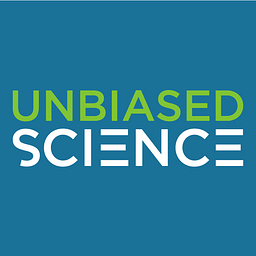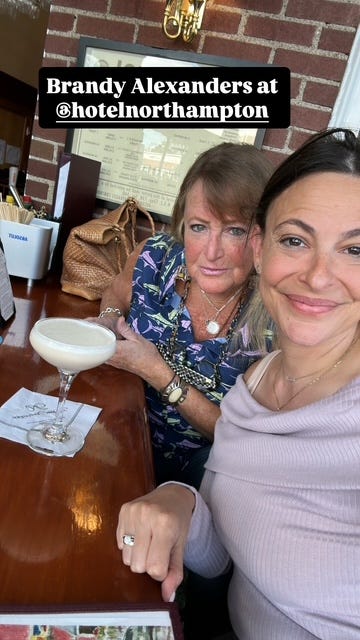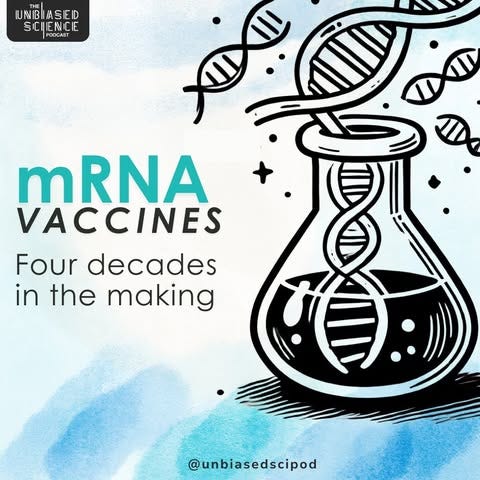A Public Health Scientist Walks Into a Bar: Science, Skepticism, and Finding Common Ground
Description
For the last few weeks of summer, my mom visited from Florida. It was amazing, as it always is, to have her here spending time with the family doing lots of things and nothing at all. Going to the lake with the kids, playing board games, having hours of conversation, and taking endless trips down memory lane. We even topped off our visit with a stop at the Hotel Northampton; it’s our tradition to sit at the front bar of the historic hotel and sip Brandy Alexanders (something she and her father did on special occasions).
The night before her flight, we stopped at one of our local spots, a dive bar/restaurant where we can be super casual and enjoy greasy bar food over drinks.
At the table next to us was a group of four men, in their late 60s or thereabouts if I had to estimate. It was clear they'd been there a while, judging from the empty beer glasses scattered across the table (no judgment). I wasn't eavesdropping, but they were talking at a high volume, so I couldn't help but hear when the topic of COVID and vaccines came up. My ears perked up like a retriever hearing the word "walk."
In particular, I heard one of the guys talking about how rushed the vaccines were and how "they" lied to us and how mRNA was an experiment and we were guinea pigs.
I did my best to stay out of it. It was Mom's last night, and I didn't want to intrude on their conversation. As a Brooklyn Jew who talks with my hands, I physically sat on my hands as if this could keep me quiet. But, alas, the science within was bursting out of me, and I leaned over and gently said, "Actually, mRNA technology has been around and tested for decades..."
And contact was made.
I shared that I'm a public health scientist, and they seemed to welcome my interjection and had more questions.
Turns out, the four guys represented a spectrum of scientific skepticism, and they were seated in order of increasing skepticism, going clockwise. One was clearly very "on board" with science and echoed my sentiments. The next two guys were quite receptive but expressed varied levels of skepticism, and the guy seated closest to me was the most vocally opposed to the health and science establishment. He was a tough nut to crack!
The conversation lasted about 15-20 minutes and was very respectful, though my exchange with the last fella did get a bit heated at times.
I thought it might be helpful to share a bit about that discussion because I'd be willing to bet that he was saying out loud what a lot of people are thinking or wondering. Let’s discuss…
1. mRNA Technology: Decades In The Making
They had no clue that mRNA technology was not new at all. They were also unaware of its applications outside of COVID-19.
The Decades-Long History
The development of mRNA vaccines spans over 40 years of research:
1978: The first successful transfection of designed mRNA packaged within a liposomal nanoparticle into a cell was published, in both mouse cells and human cells.
1990s: The first mRNA flu vaccine was tested in mice.
2013: The first human clinical trials using an mRNA vaccine against rabies began.
2023: Katalin Karikó and Drew Weissman won the Nobel Prize for their discoveries of modified nucleosides that made it possible to develop effective mRNA vaccines.
This is a very abridged summary, but this point is: mRNA technology is far from new. It faced significant challenges that took decades to overcome, including how to prevent mRNA from being rapidly degraded in the body and how to package it for effective delivery using lipid nanoparticles.
“Okay, okay– but how did we get a vaccine so quickly? We were guinea pigs.”
Operation Warp Speed: How Speed Didn't Compromise Safety
Operation Warp Speed, launched in May 2020, invested $18 billion to accelerate vaccine development. The program didn't skip safety steps; it ran them in parallel:
Clinical trial phases overlapped rather than running sequentially
Manufacturing began before trials were complete (financial risk, not safety risk)
The government pre-purchased doses to incentivize rapid development
Multiple vaccines were developed simultaneously to increase the chances of success
The speed came from removing financial barriers and bureaucratic delays, not from cutting corners on safety testing. I explained how all the research on mRNA set the stage, and we got very lucky that the vaccines were effective against SARS-CoV-2. This was news to them.
2. "They Lied to Us - The Vaccines Never Prevented COVID-19"
This complaint (that the vaccines 'never prevented COVID') was far from the first time I'd heard it. It reflects both a misunderstanding about vaccine goals and the challenge of communicating during a rapidly evolving pandemic.
The Primary Goal Was Always Preventing Severe Disease
The vaccines' main endpoint in clinical trials was preventing severe illness, hospitalization, and death, not preventing all infections. And they succeeded remarkably at this primary goal:
The original vaccines were actually quite effective at reducing transmission initially, with studies showing 40-60% reduction.
But as the virus mutated (as viruses do), particularly with the Delta and Omicron variants, the vaccines became less effective at preventing transmission.
However, they remain highly effective at keeping people alive and out of the hospital—their primary purpose.
The Communication Challenge
I addressed the communication issues with empathy. We were in the middle of a global pandemic with millions dying. Communications were made under extreme pressure, and I don't envy those officials, nor can I say with confidence I would have done things differently.
My brilliant colleague, Dr. Aimee Bernard, has a great analogy for this: every car mechanic across the U.S. doesn't have the same messaging for why you need your engine fixed or your brakes replaced. Each one explains it differently based on their knowledge, their customer, and the specific situation. Now imagine if all those mechanics had to agree on one message, deliver it simultaneously, while the cars







